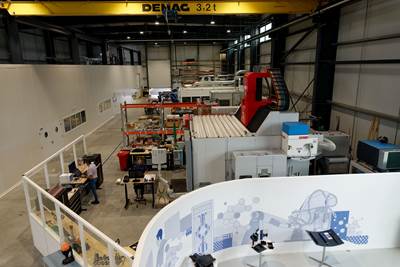Automated towpreg systems provides direct access to wet winding
CAMX 2024: Century Design Inc. highlights its OnDemand towpreg systems, designed to provide differentiation and cost efficiency in-house while maintaining high quality.
Share
Century Design Inc. (CDI, San Diego, Calif., U.S.) presents its OnDemand towpreg system, a solution for wet winding that is designed to eliminate high costs and supply chain instability.
CDI’s OnDemand towpreg system delivers a comprehensive solution by granting manufacturers direct access to “affordable” high-quality towpreg materials. With full control over material type and properties, this system enables users to bypass traditional suppliers for more consistent material procurement.
The OnDemand towpreg line features a fully automated process, only requiring a single, entry-level operator. Its compact setup, housed within a 10' × 4' footprint, can integrate seamlessly into the customer’s production environmentt, making it ideal for point-of-use application. The automated system also produces finished towpreg materials tailored to users’ specifications for immediate usability for composite part fabrication.
According to the company, one of the standout benefits of this towpreg line is its versatility — it is compatible with a wide range of industry-standard fibers and resins. Manufacturers can select from an array of customer-formulated or off-the-shelf resin systems to meet specific application needs.
“With the OnDemand material lines for parts makers, we’ve addressed the industry’s need for differentiation and cost efficiency,” says CDI’s lead engineer. “Our technology provides manufacturers with high-quality, customizable products while significantly lowering overall production costs.”
Bringing material production in-house can offer substantial benefits for wet winders. By eliminating the need for external suppliers, manufacturers have the ability to gain full control over production schedules, which further enhances efficiency and reduces lead times. This capability also facilitate rapid optimization of material properties and configuration to best suit downstream processing needs.
The modular design of CDI’s towpreg system is engineered to support not only R&D and small-scale production, but also scaling for high-volume production.
Related Content
-
Filament winding increases access to high-performance composite prostheses
Steptics industrializes production of CFRP prostheses, enabling hundreds of parts/day and 50% lower cost.
-
Anemoi installs 35-meter-tall composite rotor sails on Sohar Max maritime vessel
Carbon fiber-reinforced epoxy composites are key to building these long-lasting wind propulsion technologies for energy-efficient watercraft.
-
Plant tour: Hexagon Purus, Kassel, Germany
Fully automated, Industry 4.0 line for hydrogen pressure vessels advances efficiency and versatility in small footprint for next-gen, sustainable composites production.
Related Content
Filament winding increases access to high-performance composite prostheses
Steptics industrializes production of CFRP prostheses, enabling hundreds of parts/day and 50% lower cost.
Read MoreAnemoi installs 35-meter-tall composite rotor sails on Sohar Max maritime vessel
Carbon fiber-reinforced epoxy composites are key to building these long-lasting wind propulsion technologies for energy-efficient watercraft.
Read MorePlant tour: Hexagon Purus, Kassel, Germany
Fully automated, Industry 4.0 line for hydrogen pressure vessels advances efficiency and versatility in small footprint for next-gen, sustainable composites production.
Read MoreSRI develops scalable, infiltration-free ceramic matrix composites
Work in two DOE projects is demonstrating C/C-SiC produced in 3-5 days with <5% shrinkage, <10% porosity and 50% the cost of conventional C/C and C/C-SiC.
Read MoreRead Next
Plant tour: Daher Shap’in TechCenter and composites production plant, Saint-Aignan-de-Grandlieu, France
Co-located R&D and production advance OOA thermosets, thermoplastics, welding, recycling and digital technologies for faster processing and certification of lighter, more sustainable composites.
Read MoreAll-recycled, needle-punched nonwoven CFRP slashes carbon footprint of Formula 2 seat
Dallara and Tenowo collaborate to produce a race-ready Formula 2 seat using recycled carbon fiber, reducing CO2 emissions by 97.5% compared to virgin materials.
Read MoreAssembling the Multifunctional Fuselage Demonstrator: The final welds
Building the all-thermoplastic composite fuselage demonstrator comes to an end with continuous ultrasonic welding of the RH longitudinal fuselage joint and resistance welding for coupling of the fuselage frames across the upper and lower halves.
Read More











